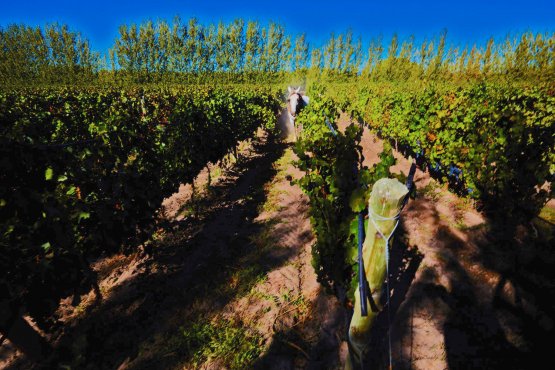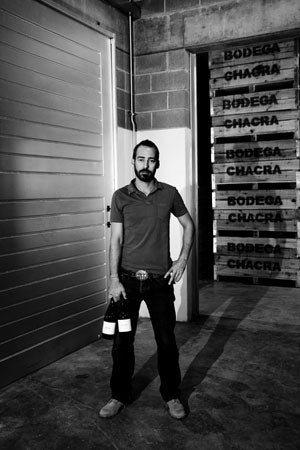Source: The Pour (NYT) Words by: Eric Asimov
MAINQUÉ, Argentina — The flat, dry Río Negro Valley on the northern end of Patagonia won’t strike anybody as a glamorous wine region. For one thing, apple and pear orchards, along with platoons of poplar trees, far outnumber grapevines. For another, the restaurants, hotels and the usual camp followers of the winemaking life are nowhere to be found.
But glamour did not draw Piero Incisa della Rocchetta to the Río Negro. The old pinot noir vines did, along with promising soils, a sparkling climate and a dream of creating a self-sustaining wine estate the way his grandfather the Marchese Mario Incisa della Rocchetta did in Italy 50 years ago. The marchese created Sassicaia, a paradigm-breaking cabernet blend that proved greatness could be achieved in Bolgheri, on the Tuscan coast.
Dreams and inherited wealth have fueled more than a few wine start-ups, but rarely in so unprepossessing a place and with so untested a notion as Argentine pinot noir. Unlike many start-ups, though, Mr. Incisa’s estate, Bodega Chacra, is producing wines that decisively earn whatever attention his family history initially brings him.

Argentina is known for one wine, malbec. The prevailing style of these wines, grown mostly in the province of Mendoza to the northwest, is the antithesis to good pinot noir; powerfully fruity, opulent and often highly alcoholic and oaky. By contrast, good pinot noir is known for its elegance and finesse, characteristics that Mr. Incisa has managed to achieve in his Chacra wines in just a decade.
A 2012 Treinta y Dos, made from pinot noir vines planted in 1932 by Italian immigrants, is a savory delight, graceful and lithe with flavors of red fruits and flowers tempered by minerals. A 2013 Cincuenta y Cinco, from vines planted in 1955, is likewise beautifully balanced and floral, with an umami quality. Even Mr. Incisa’s bigger-production 2014 Barda, made from younger vines, shares their tangy, floral, energetic qualities, though without the extra depth of the other pinot noirs.
 While pinot noir may not be associated with Argentina, it’s not unknown. Fifty years ago, Mr. Incisa said, more than 4,000 acres in Patagonia were planted with pinot noir. Most of those grapes went into sparkling wines. Chandon Argentina, for example, a subsidiary of the Champagne producer Moët & Chandon, has been making sparkling wines in Argentina for more than 65 years. But many of those grapes are now in other regions. By 2000, Mr. Incisa said, less than 500 acres of pinot noir remained in Patagonia.
While pinot noir may not be associated with Argentina, it’s not unknown. Fifty years ago, Mr. Incisa said, more than 4,000 acres in Patagonia were planted with pinot noir. Most of those grapes went into sparkling wines. Chandon Argentina, for example, a subsidiary of the Champagne producer Moët & Chandon, has been making sparkling wines in Argentina for more than 65 years. But many of those grapes are now in other regions. By 2000, Mr. Incisa said, less than 500 acres of pinot noir remained in Patagonia.
From those remaining vines came a pinot noir that Mr. Incisa tasted blind in 2001. He was impressed with the wine, which had been made by a Dutch wine consultant, Hans Vinding-Diers, for Humberto Canale, a pioneering Patagonian producer. So impressed that he was determined to see the source of those grapes. He finally visited in 2004.
He found an old stand of pinot noir dating from 1932. He was struck by the dry climate, the fresh breeze that seemed to blow constantly from the Andes in the west and the brilliance of the sunlight. Though technically a desert, bounded by rivers flowing from the mountains into the Río Negro, the region was irrigated by canals dug by British colonists in the 19th century.
dry climate, the fresh breeze that seemed to blow constantly from the Andes in the west and the brilliance of the sunlight. Though technically a desert, bounded by rivers flowing from the mountains into the Río Negro, the region was irrigated by canals dug by British colonists in the 19th century.
But Mr. Incisa was disturbed by the condition of the vines, which had long been neglected, and of the soils — gravel, sand, limestone and clay — which seemed gray and lifeless. Taking a chance, he bought the land and the vines and set about building his estate. He has since supplemented the oldest vines with several additional pinot noir vineyards.
“I was the idiot guy with a fair dose of not knowing what I didn’t know,” Mr. Incisa said as we walked the vineyards, now alive with birds, bees, bats and other signs of a healthy environment, the result of biodynamic viticulture. “Maybe I had the idea of getting out of a family trajectory, which was very privileged but maybe not so much of a challenge for me. Plus, I had a passion for pinot.”
Mr. Incisa, now 48, has a history of adapting to new environments. He was born in Bolgheri, and spent his early childhood there and in Florence. He went to boarding school in Switzerland, college in California, and now commutes between Patagonia, New York and Italy.
As he established himself in Patagonia, he found something of a guide in Mr. Vinding-Diers, who by then had his own label, Bodega Noemía, making Patagonian malbec. Mr. Vinding-Diers allowed him to use his winery until his own was completed. Mr. Incisa’s first vintage was 2004, and he called it Chacra, a regional term meaning “farm.”
“I wanted to use a local word,” he said. “Here, I’m very much of a stranger.”
Despite the condition of the vines and soil, Mr. Incisa said, the vineyards came with built-in advantages. In the fresh Patagonian climate, there were none of the usual problems — humidity, fungus, mildew, pests. Unlike the vines in most of the great vineyards of Europe and the world, which are grafted onto American rootstocks to combat the threat of phylloxera, an aphid that devastates grapevines, Mr. Incisa’s vines, even the younger ones he has planted to supplement his old stands, are ungrafted.
“We know it’s sort of a gamble,” he said, “but if at 85 years old the vines are doing well, we figure we don’t need to change.”
Adapting to local custom, Mr. Incisa has planted rows of poplars around the vineyards and in between different blocks to protect the vines from the stiff, incessant wind. He has planted cover crops in between the rows of vines to absorb heat from the summer sun and has sculpted the canopy of leaves over the vines so that the grapes ripen slowly in the luminous light.
“We’re looking for something on the feminine, softer side rather than big and tannic,” he said. “I always want freshness, good acidity and, as a byproduct, low alcohol.”
In the low, sandstone winery Mr. Incisa built, the grapes are handled as little as possible. They are fermented in epoxy-lined cement tanks, mostly as whole bunches, with indigenous yeast. The wine then ages in French oak barrels until bottling. The wines are neither fined nor filtered, and receive a minimal dose of sulfur dioxide as a preservative. Mr. Incisa is experimenting with small cuvées that receive no sulfur at all.
As he has become more confident in his winemaking, his wines have become more precise and transparent. He has cut back on the use of new oak, harvested earlier and become more delicate in the winery.
“There is not a right or wrong,” he said. “There is just personal taste.”
![]() Working in virtually the middle of nowhere (the nearest city, Neuquén, is more than an hour’s drive away) and in an often dysfunctional Argentine economy has its challenges. Equipment is difficult to repair or replace, and a lack of technical support means Mr. Incisa and his local team must figure things out for themselves.
Working in virtually the middle of nowhere (the nearest city, Neuquén, is more than an hour’s drive away) and in an often dysfunctional Argentine economy has its challenges. Equipment is difficult to repair or replace, and a lack of technical support means Mr. Incisa and his local team must figure things out for themselves.
“You learn to make do, conserve, be efficient,” he said. “Keep everything cheap, local and good for the environment.”
Winemaking can also be dangerous. In 2012, while working in his winery, Mr. Incisa slipped off the edge of a tank and fell backward onto the floor below, where he remained for hours until he was discovered. He broke his leg in many places and was in a wheelchair for three months.
He decided  life was too short to play it safe. He would take chances to make the wines that he wanted.
life was too short to play it safe. He would take chances to make the wines that he wanted.
“The most beautiful thing in my life was the accident,” he said. It has given him perspective on his project. “It’s taken a small series of miracles to make this work,” Mr. Incisa added. “I attach more to the process than the outcome.”
His 2015s may be his best wines yet. Tasted from barrels, where they are still aging, they are fresh and energetic with crunchy fruit flavors and that characteristic savory quality.
Nonetheless, persuading the rest of the world to take interest in Argentine pinot noir has proved a challenge. With so much other good pinot noir in the world, why should anybody drink his?
“Hopefully, because you are curious and want to explore,” he said. “It’s an expression of pinot noir that’s different.”
A version of this article appears in print on Jan. 27, 2016, Section D, Page 6 of the New York edition with the headline: Pinot Noir That Stands Out in a Sea of Malbecs.


